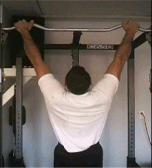
Pull-ups are a common bodyweight exercise.
Bodyweight exercises are strength training exercises that do not require free weights; the practitioner's own weight provides the resistance for the movement. Movements such as the push-up, the pull-up, and the sit-up are some of the most common bodyweight exercises.
Advantages[]
Because they do not require weights, bodyweight exercises are the ideal choice for individuals who are interested in fitness but do not have access to strength training equipment. Weights can be incorporated to increase the difficulty of most bodyweight exercises and some exercises do require some sort of apparatus to lean on or hang from, but the majority of bodyweight exercises require only a floor. For those exercises that do require equipment of some kind, a substitute can usually be improvised, for example using a tree branch to perform pull-ups.
Disadvantages[]
Bodyweight exercises use the practitioner's own weight to provide the resistance for the movement. This means that the weight being lifted is always the same. This makes it difficult for less experienced athletes to achieve a level of intensity that is near their one rep maximum, which is desirable for strength training. Other methods for increasing intensity include using additional weights (such as wearing a weighted vest or holding a barbell or plate during a sit up) or by altering the exercise to put yourself at a leverage disadvantage (such as elevating the feet or using only one hand during a push-up). Gymnasts make extensive use of this last technique by doing much of their training with straight arms (such as iron crosses, levers, and planches), a mechanically disadvantaged position. Furthermore, a unilateral progression scheme can be used. Instead of a bilateral movement, such as a two-handed pull-up, the practitioner may decide, for strength increases, to choose a set of exercises that will allow him/herself to complete the one-arm pull up. In the bodyweight-training community, unilateral movements are highly regarded and sought after.
List of exercises[]
This is a list of common bodyweight exercises. Most of these exercises have several variants that can be performed to make the exercise more or less challenging, or to train different muscles. These variants are described in the articles covering the individual exercises.
| Name | Muscle groups | Description |
|---|---|---|
| Dip | Arms (triceps), chest, back | Hanging from a dip bar or other implement with the arms straight and the shoulders positioned above the hands, the body is lowered until the arms are bent at a 90 degrees angle. |
| Press-up / Push-up |
Chest, arms (triceps) | In a prone position, the body is raised and lowered using the arms while the back remains straight and the toes remain on the ground. |
| Pull up | Back | Hanging from a bar with arms extended and palms facing away from the exerciser, the body is pulled up until the elbows are bent and the head is higher than the hands. |
| Chin-up | Back | Like the pull-up, but with the palms facing towards the exerciser. |
| Crunch | Abdomen | Lying face up on the floor, the shoulders are curled towards the pelvis until the lower back is about to leave the floor. |
| Sit-up | Abdomen, hip flexors | It begins with lying with the back on the floor, typically with the knees bent in an attempt to reduce stress on the back muscles and spine, and then elevating both the upper and lower vertebra from the floor until everything superior to the buttocks is not touching the ground. |
| Russian twist | Abdomen | Sitting on the floor with knees bent as in a sit-up, with the back kept straight and at a 45 degree angle to the floor, the straightened arms are held outstretched with the hands locked together. The arms are moved from one side of the body to another in a twisting motion. |
| Squat | Legs | Standing up, the legs are bent at the knees and hips, lowering the torso between the legs. The torso leans forward to maintain balance. (Usually called a bodyweight squat to distinguish it from the use of weights.) |
See also[]
- Bodybuilding
- Calisthenics
- Circuit training
- General fitness training
- Health club
- Physical exercise
- Physical fitness
- Plyometrics
- Resistance training
- Strength training
- Stretching
- Supercompensation
- List of weight training exercises